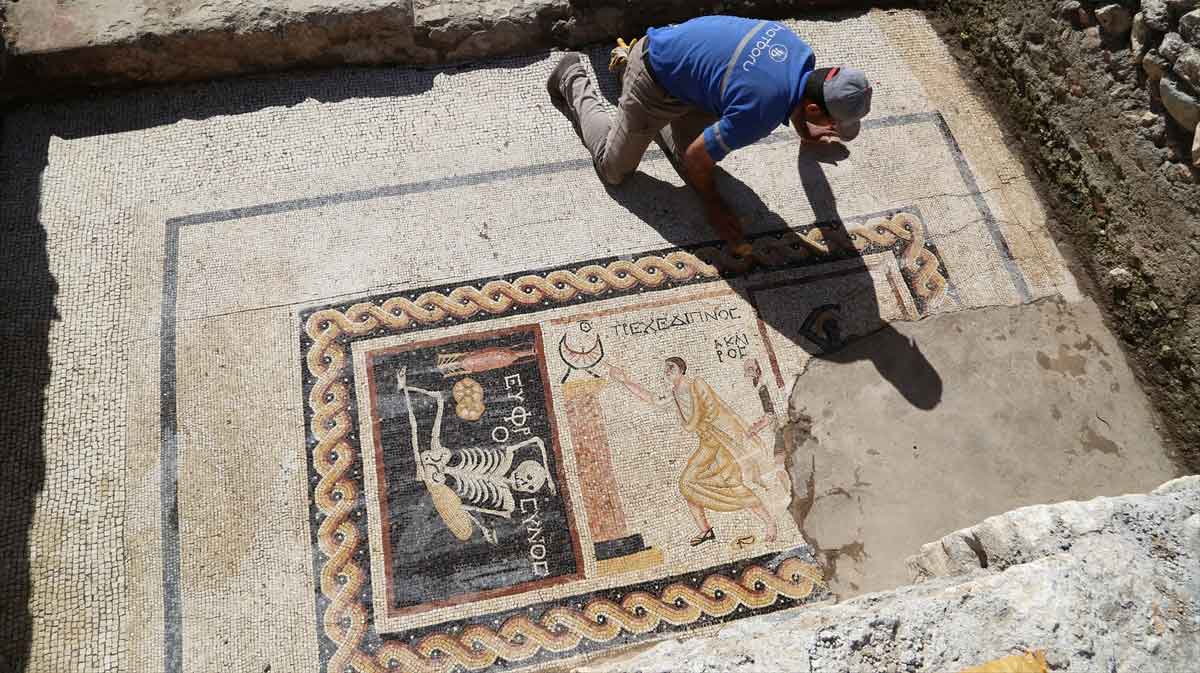What's New Under The Sun
Madison Historic Dial Returns
Monday, 13 October 2025 22:49
 On October 4, 2025 Madison Historical Society of Ohio was able to have their sundial returned after 32 years, when in 1993 it was moved to the lawn of Lake County Courthouse to reduce the chance of vandalism. The sundial was originally placed at Madison Home 100 years ago on Saturday, October 24, 1925 during a conference of the Women's Relief Society. From 1904 to 1962 the state ran this...
On October 4, 2025 Madison Historical Society of Ohio was able to have their sundial returned after 32 years, when in 1993 it was moved to the lawn of Lake County Courthouse to reduce the chance of vandalism. The sundial was originally placed at Madison Home 100 years ago on Saturday, October 24, 1925 during a conference of the Women's Relief Society. From 1904 to 1962 the state ran this...
Elements of Dialing Course - 2025
Monday, 15 September 2025 19:42
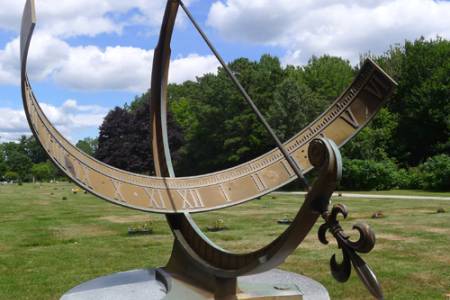 NASS is pleased to announce the upcoming fifth instance of Elements of Dialing, our introductory course about sundials, their history, and the science that makes them work. The free 12-lesson course, intended for those are new to sundialing, runs from 27 October 2025 until 26 April 2026. The course instructor is Robert Kellogg, NASS Vice President and Sundial Registrar. Bob will be...
NASS is pleased to announce the upcoming fifth instance of Elements of Dialing, our introductory course about sundials, their history, and the science that makes them work. The free 12-lesson course, intended for those are new to sundialing, runs from 27 October 2025 until 26 April 2026. The course instructor is Robert Kellogg, NASS Vice President and Sundial Registrar. Bob will be...
Sun Queen of World War II
Thursday, 11 September 2025 23:11
 A Hungarian born American scientist, Mária Telkes (1900-1995), was called "The Sun Queen" and among other honors, was postmousthly inducted into the National Inventors Hall of Fame. She lived to 95 and for most of her life developed solar power in a variety of forms.
Trained as a biophysicist, she worked for Westinghouse Electrical and Manufacturing Company in Pittsburgh, PA, where she...
A Hungarian born American scientist, Mária Telkes (1900-1995), was called "The Sun Queen" and among other honors, was postmousthly inducted into the National Inventors Hall of Fame. She lived to 95 and for most of her life developed solar power in a variety of forms.
Trained as a biophysicist, she worked for Westinghouse Electrical and Manufacturing Company in Pittsburgh, PA, where she...
2025 Conference -Ottawa
Thursday, 28 August 2025 23:25
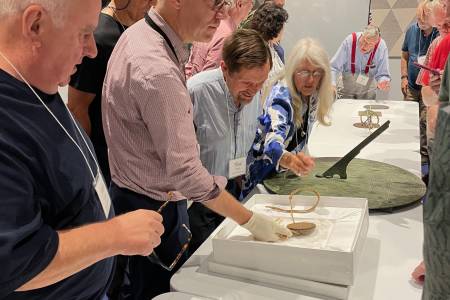 The annual NASS Conference was held 7-10 August, 2025 in Ottawa. As usual, the conference began late Thursday afternoon with an introduction social and a "grab bag give away", taking your chances with tickets to win the bag's prize. Will Grant was the final winner of the Walton Double Planar Polar Sundial, but Paul Ulbrich beat the statistic odds and won this prize three times,...
The annual NASS Conference was held 7-10 August, 2025 in Ottawa. As usual, the conference began late Thursday afternoon with an introduction social and a "grab bag give away", taking your chances with tickets to win the bag's prize. Will Grant was the final winner of the Walton Double Planar Polar Sundial, but Paul Ulbrich beat the statistic odds and won this prize three times,...
Prosciutto di Portici Sundial's Owner
Tuesday, 10 June 2025 18:51
 Prosciutto di Portici (Ham) Sundial
Photo: Getty Images
The Prosciutto di Portici Sundial, more often called the Portici Ham Sundial, dates from the first century somewhere between 8 BCE to 79 CE. This small silvered bronze dial was uncovered on 11 June, 1755 in the ruins of Herculaneum (current day Portici) in the "Villa of the Papyri", buried in...
Prosciutto di Portici (Ham) Sundial
Photo: Getty Images
The Prosciutto di Portici Sundial, more often called the Portici Ham Sundial, dates from the first century somewhere between 8 BCE to 79 CE. This small silvered bronze dial was uncovered on 11 June, 1755 in the ruins of Herculaneum (current day Portici) in the "Villa of the Papyri", buried in...
Hamilton Dial Dedicated
Friday, 06 June 2025 21:01
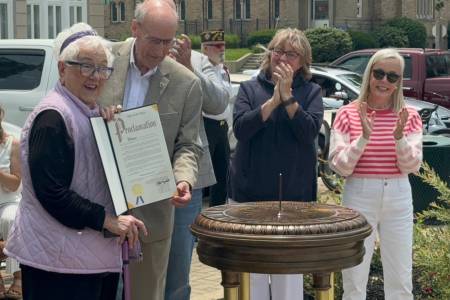 Sundial dedication May 31, 2025. At left is Kathleen Stuckey Fox, with the City Proclamation presented by Mayor Pat Moeller and City Council on-lookers Carla Fiehrer and Susan Vaughn offering congratulations.
On May 31, 2025 at 1pm, the Hamilton, Ohio, sundial (NASS Sundial Registry #1109) was re-dedicated in Monument Park. Originally dedicated in 1941 to the...
Sundial dedication May 31, 2025. At left is Kathleen Stuckey Fox, with the City Proclamation presented by Mayor Pat Moeller and City Council on-lookers Carla Fiehrer and Susan Vaughn offering congratulations.
On May 31, 2025 at 1pm, the Hamilton, Ohio, sundial (NASS Sundial Registry #1109) was re-dedicated in Monument Park. Originally dedicated in 1941 to the...
Frans Maes Received a Royal Decoration
Monday, 24 March 2025 21:33
 Several years ago Frans decided to write the course on sundials that included self assessment questions to force students not only to read the text, but to internalize the concepts. And a final submittal question "not necessarily a difficult question, but: no answer, no new lesson." Thus Frans Maes began writing lessons and sending them out to students.
NASS has now used his material to create...
Several years ago Frans decided to write the course on sundials that included self assessment questions to force students not only to read the text, but to internalize the concepts. And a final submittal question "not necessarily a difficult question, but: no answer, no new lesson." Thus Frans Maes began writing lessons and sending them out to students.
NASS has now used his material to create...
Pros and Cons of Daylight Savings Time
Monday, 24 March 2025 15:37
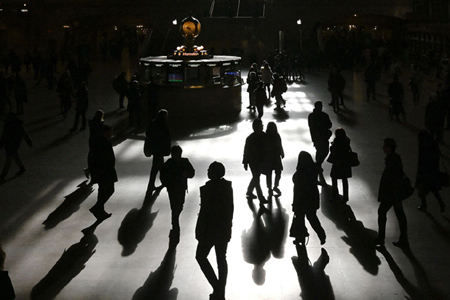 In a 24 March 2025 article from the on-line Science Advisor (American Association for the Advancement of Science) Phie Jacobs summarizes the "great debate" of the yearly shift from standard time to daylight savings time. In January 2025 the US Senate introduced the Sunshine Protection Act to permanently have daylight savings time year round. Certainly 54% of Americans do not like the...
In a 24 March 2025 article from the on-line Science Advisor (American Association for the Advancement of Science) Phie Jacobs summarizes the "great debate" of the yearly shift from standard time to daylight savings time. In January 2025 the US Senate introduced the Sunshine Protection Act to permanently have daylight savings time year round. Certainly 54% of Americans do not like the...
Native American Moon Alignment Ring
Friday, 21 March 2025 19:26
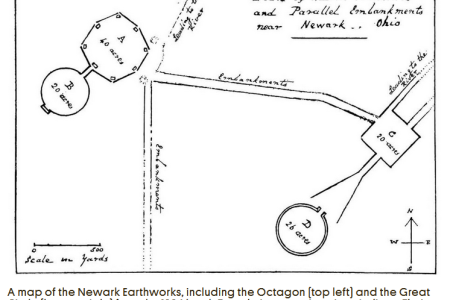 Perhaps the most famous alignment circle in the United States is the Cahokia Woodhenge near St. Louis constructed between 700-1400 CE by Cahokia Indigenous native Americans. But there were an estimated 10,000 other earthen mounds that once were scatter across the mid-west..
In an article from Atlas Obscura (https://www.atlasobscura.com/articles/octagon-earthworks-ohio) by Olivia Young on March...
Perhaps the most famous alignment circle in the United States is the Cahokia Woodhenge near St. Louis constructed between 700-1400 CE by Cahokia Indigenous native Americans. But there were an estimated 10,000 other earthen mounds that once were scatter across the mid-west..
In an article from Atlas Obscura (https://www.atlasobscura.com/articles/octagon-earthworks-ohio) by Olivia Young on March...
Hamilton Dial under Restoration
Friday, 21 March 2025 18:37
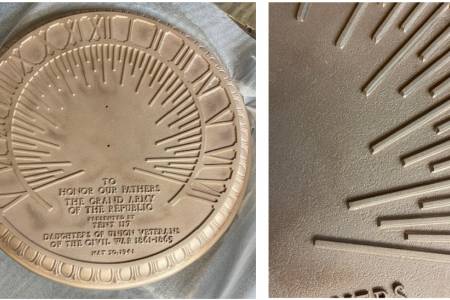 The Hamilton dial is in the restorative care of Jarrett and Celene Hawkins (Hawkins & Hawkins Custom, LLC in Cincinnati Ohio https://www.studio-hawkins.com/) in preparation for the dial's dedication on Saturday, May 31, 2025.
The face of the Hamilton Grand Army of the Republic (GAR) sundial has been cleaned and bead-blasted showing the dial as it was cast 84 years ago. In the process,...
The Hamilton dial is in the restorative care of Jarrett and Celene Hawkins (Hawkins & Hawkins Custom, LLC in Cincinnati Ohio https://www.studio-hawkins.com/) in preparation for the dial's dedication on Saturday, May 31, 2025.
The face of the Hamilton Grand Army of the Republic (GAR) sundial has been cleaned and bead-blasted showing the dial as it was cast 84 years ago. In the process,...
VSSC Space Museum gets Polar Sundial
Tuesday, 17 December 2024 23:47
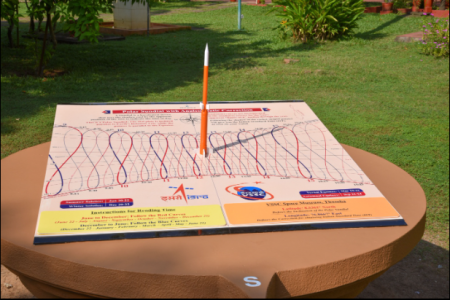 In November 2024, a team consisting of members from SPL, TTDG and CMD of VSSC successfully designed and installed an accurate and fully functional sundial at the Rocket Garden of VSSC Space Museum, Thumba (8.53°N, 76.86°E). Following a space theme, the vertical gnomon is a 3-stage rocket that casts its daily and seasonal shadow on a dial face 1 1/2 meters by 1 meter. The the sundial face...
In November 2024, a team consisting of members from SPL, TTDG and CMD of VSSC successfully designed and installed an accurate and fully functional sundial at the Rocket Garden of VSSC Space Museum, Thumba (8.53°N, 76.86°E). Following a space theme, the vertical gnomon is a 3-stage rocket that casts its daily and seasonal shadow on a dial face 1 1/2 meters by 1 meter. The the sundial face...
Historic Sundials of Andalusia
Saturday, 16 November 2024 00:07
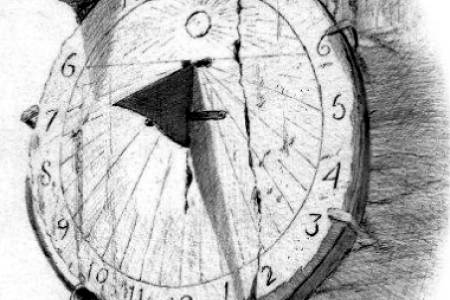 Esteban Martínez Almirón has published a new book Historical Sundials: Forgotten Andalusian Treasures (Relojes de Sol Históricos Tesoros Andaluces Olvidados) In it he reviews over 400 sundials from the Andalucian region of southern Spain Originally to celebrate the 25th year of the website https://relojandalusi.org/
Esteban Martínez Almirón began showing his sundial drawings on the site....
Esteban Martínez Almirón has published a new book Historical Sundials: Forgotten Andalusian Treasures (Relojes de Sol Históricos Tesoros Andaluces Olvidados) In it he reviews over 400 sundials from the Andalucian region of southern Spain Originally to celebrate the 25th year of the website https://relojandalusi.org/
Esteban Martínez Almirón began showing his sundial drawings on the site....
Pleistocene Sunburst Pocket-Art Unearthed
- Details
- Hits: 11690
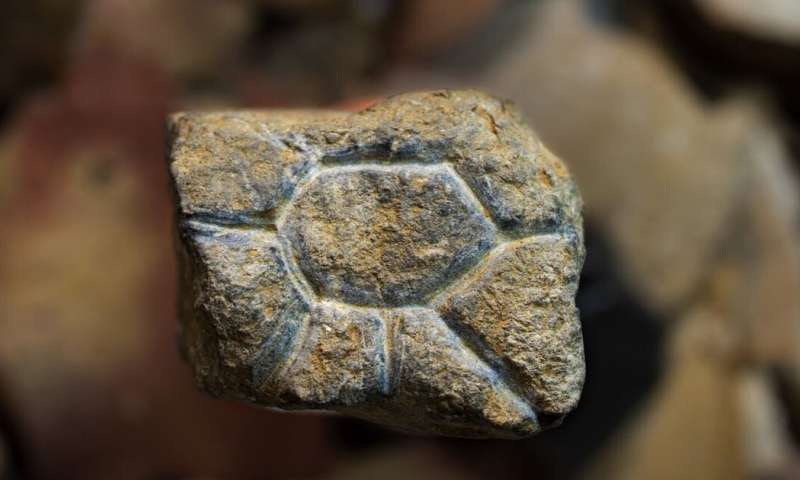 Photo Credit: Andrew Thompson Photo Credit: Andrew Thompson |
Archaeologists have found two miniature stone engravings in a cave on the island of Sulawesi in Indonesia. One plaquette appears to be a sunburst, the other an ibex like animal, the anoa. These pocket-sized carvings dating back between 14,000 and 26,000 years. Elsewhere in Sulawesi the oldest cave art dating to 44,000 years ago was recently discovered, dispelling the Euro-centric notion of Pleistocene art.
Examining the incisions cut into the ancient flowstone, the Sunburst hexegon outline was carved starting in the photo from upper left, with continuing connecting lines done clockwise. Then the 7 rays were added. Small traces of a red mineral (perhaps red ochre pigment) exist in some of the sunburst cuts, possibly indicating that the sun was enhanced in a beautiful red color. Before this discovery the oldest known depiction of the sun was from the Nebra sky disk found in Germany and fabricated of metal 3,600 years ago, rivaling Pharaoh Akenaten who built a whole city to the glory of the sun (Aten) 3,365 years ago. These are recent times compared to the sunburst.
The archaeology team was lead by Michelle C. Langley of the Australian Research Centre for Human Evolution, Griffith University, with associates at Arkeologi Nasional (ARKENAS), Jakarta, Balai Arkeologi Sulawesi Selatan and Balai Pelestarian Cagar Budaya in Makassar. They report in Nature Human Behaviour "... the discovery of two small stone ‘plaquettes’ incised with figurative imagery dating to 26–14 ka from Leang Bulu Bettue, Sulawesi. [The pocket-art was discovered in a cave and rockshelter complex of Leang Bulu Bettue (4° 59' 31.18" S, 119° 40' 5.53" E) situated at the foot of a limestone tower in the Maros-Pangkep karst area.] These new findings, together with the recent discovery of rock art dating to at least 40 ka in this same region, overturns the long-held belief that the first H. sapiens of Southeast Asia–Australasia did not create sophisticated art and further cements the importance of this behaviour for our species’ ability to overcome environmental and social challenges."
The artefacts reported here are currently curated at the Australian Research Centre for Human Evolution, Griffith University, Nathan, Australia. They will return to Indonesia at the conclusion of the project where they will be given accession numbers and be curated in Makassar by Balai Arkeologi Sulawesi Selatan.
Read more at:
Hemicyclium Sundial Discovered in Turkey
- Details
- Hits: 17283
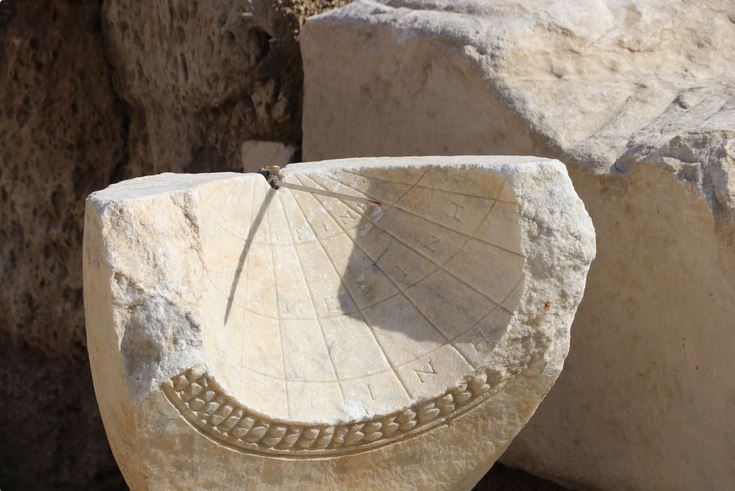 Several years ago in 2017 archaeologists found a rare hemicyclium sundial. Now another hemicyclium in excellent condition has been unearthed in Turkey's city of Denizli. Celal Şimşek, chief archaeologist at Denizli's Pamukkale University, calls it "unique". A better word is rare. Less than a hundred examples of this type of Hellenistic sundial have survived. It was found in the ancient city of Laodicea about 370 miles south of Istanbul. The sundial seems to have come from the archaeological site of one of the temples. As reported in the Daily Sabah, "Among the rare, largely preserved buildings in the city are the largest ancient stadium in Turkey, a theater and a sacred agora." The hemicyclium of pink marble has an outer edge decorated in foliage while the interior hemisphere has the traditional Greek names of the seasons. Hour lines deliniate the time. Almacantor lines show the solstices and a great circle marks the equinox. In AA Photo of the sundial at right, a needle gnomon has been restored to show how the sundial casts a shadow. Time and season are read at the gnomon shadow's tip.
Several years ago in 2017 archaeologists found a rare hemicyclium sundial. Now another hemicyclium in excellent condition has been unearthed in Turkey's city of Denizli. Celal Şimşek, chief archaeologist at Denizli's Pamukkale University, calls it "unique". A better word is rare. Less than a hundred examples of this type of Hellenistic sundial have survived. It was found in the ancient city of Laodicea about 370 miles south of Istanbul. The sundial seems to have come from the archaeological site of one of the temples. As reported in the Daily Sabah, "Among the rare, largely preserved buildings in the city are the largest ancient stadium in Turkey, a theater and a sacred agora." The hemicyclium of pink marble has an outer edge decorated in foliage while the interior hemisphere has the traditional Greek names of the seasons. Hour lines deliniate the time. Almacantor lines show the solstices and a great circle marks the equinox. In AA Photo of the sundial at right, a needle gnomon has been restored to show how the sundial casts a shadow. Time and season are read at the gnomon shadow's tip.
Read more at: https://www.dailysabah.com/life/history/2000-year-old-sundial-unearthed-in-southern-turkeys-denizli
ADDENDUM FROM SUNDIAL DIGEST - 10 April 2020
I would like to add two arguments to the questions [of the sundial's age] under discussion:
1. Prof. Şimşek said: “On the North Parados passage in the Western Theater, which dates back to the Hellenistic Era, in the ancient city we have found a spherical sundial facing south, which we believe to be 2,020 years old.
This is a kind of conclusion which does not help by dating the dial. A comparison with similar specimens reveals that it was probably done around 200 – 400 CE.
2. “Inscribed on the dial are the Greek word ‘Ksimerini’, or winter on the upper part; ‘Isimerini’, or solstice, which denotes the equality of day and night in the middle; and ‘Terini’, or summer in the bottom.”
I read (ΤΡΟΠH) ΧΕ(Ι)ΜΕΡΙΝH / IΣΗΜΕΡΙΝH / (ΤΡΟΠH) ΘΕΡΙΝH.
These are the names of the solstices and the equinoxes. What is conspicuous is the missing of I in χειμερινή (it should be written with diacritic signs). That is another strong argument that it was done in the Roman era.
With best wishes
Karlheinz Schaldach
Sundial Discovered in Madaba Map Mosaic
- Details
- Hits: 13194
We've reported on ancient mosaics from Turkey showing sundials (Antioch Mosaic Sundial - 2016). Now from the Ministry of Sciences and Higher Education in Poland ( Archaeology News - Ancient Sundial and Science in Poland ) another ancient mosaic sundial has been discovered:
Sundial in the Madaba Map, a great mosaic located in Jordan. The sundial is located next to the gate on the left. Credit Wikipedia/public domain.
Professor Marek T. Olszewski from the University of Warsaw was re-examining a number of mosaics dating back to the 2nd century AD when he made his startling discovery.
One of the mosaics from the 6th century AD which was discovered by the Gate of Damascus in Jerusalem, Olszewski noticed that between a richly dressed women, a mysterious object is visible, which scientists at the beginning of the 20th century described as an oil lamp or column.
Olszewski said: ”After careful analysis and comparison with a sundial discovered during excavations, I came to the conclusion that this mosaic and other ones similar to it depict sundials....
Another sundial "tracked" by the Polish researcher is located in a wall mosaic in Santa Cecilia in Trastevere church in Rome. This mosaic was created during the time of Pope Paschal I (817-824).
Prof. Olszewski also noticed a previously unknown sundial in the Madaba Map - a huge floor mosaic, which is currently stored in the church of St. George in Madaba, Jordan. It shows a map of the Middle East from the Byzantine period. This is the oldest cartographic depiction of the Holy Land, including Jerusalem and dates back to the 6th century AD.
Yet another depiction of a sundial comes from Tarsus (Mersin) in Turkey, where a figural mosaic (ca. 2nd-3rd century AD) shows a sundial on a column and a crow sitting on it. A man tries to scare off the bird by throwing a pouch at it (crow was a symbol of a bad omen).
Professor Olszewski has now discovered eight previously unknown sundials in the designs, taking the total number known to 15.
Time and Cosmos
- Details
- Hits: 14895
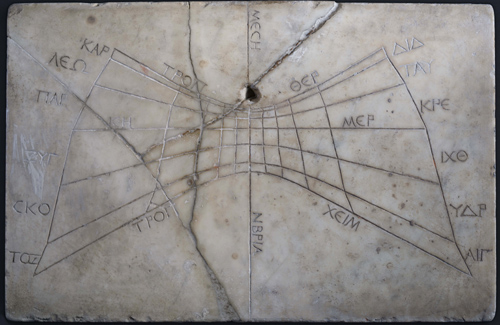
Horizontal Gnomonic Dial (Inv. 3075)
by permission
Museo Archeologico Nazionale di Napoli
|
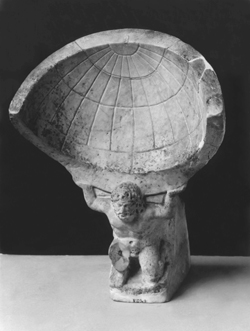
Statuette of Atlas Bearing a Hemispherical Sundial
by permission
Sir John Soane's Museum, London
|
The Institute for the Study of the Ancient World (15 East 84th Street in New York) is hosting an exhibition "Time and Cosmos in Greco-Roman Antiquity" open to the public from now until April 23, 2017. From their on-line invitation, "This exhibition aims to explore the ways that time was organized and kept track of in the Greco-Roman world, and how it was conceived in relation to the Cosmos. The objects displayed include artifacts illustrating the technology of ancient time-reckoning and the perception, visualization, and social role of time and cosmos..." This is exemplified by a wonderful horizontal gnomonic sundial using a vertical gnomon shown at left. It was found at Pompeii around 1865 and became part of the Museo Archeologico Nazionale di Napoli in 1867. "Despite the fact that it was found in Italy, the inscriptions on it are in Greek, perfhaps reflecting the status of Greek as the langauage of science in antiquity. The summer and winter tropics (solstices), equinox, and seasons are reasonably declined. The hour lines however reflect temporal hours rather than the hour angles we would draw todayl.
Athens Tower of Winds Opens to Public
- Details
- Hits: 24837
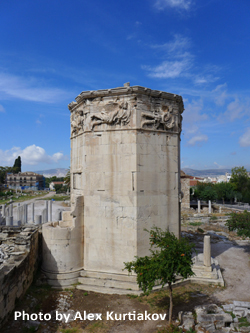 In the old Roman Agora on the slope of Athen's ancient Acropolis hill is the Tower ofWinds. Today, completing two years of restoration, the interior was re-opened to the public this summer in August, 2016. The Tower had been closed for the last 200 years. The story of the Tower starts in the first century, BCE, probably during the reign of Julius Caesar.
In the old Roman Agora on the slope of Athen's ancient Acropolis hill is the Tower ofWinds. Today, completing two years of restoration, the interior was re-opened to the public this summer in August, 2016. The Tower had been closed for the last 200 years. The story of the Tower starts in the first century, BCE, probably during the reign of Julius Caesar.
The Tower was designed by Andronikos Kyrrhestos (Andronicus of Cyrrhus), an astronomer and maker of celestial instruments. Andronicus constructed a white marble sundial for the sanctuary of Poseidon and Amphitrite on the island of Tinos. The sundial becamse so famous that Andronicus was invited to Athens where he erected the magnificent 14 meter Tower called the Aerides (the Winds) . It was built on the eastern side of the Roman Agora in Athens and meant to have utilitarian value. "No one knows who funded its lavish construction - the octagonal monument is made almost entirely of Pentelic marble, the same used for the Parthenon and rarely found in buildings other than temples," said Stelios Daskalakis, head conservator.
Atop of the octogon tower now rests the fully-preserved roof made of 24 marble slabs, resting on a Corinthian capital. Once a bronze statue of Trition, the god of the sea, was set on the roof to turn in the wind as a weather indicator. By night, water flowed through a hydro-mechanical system designed by Andronicus from a cylinder inside the Tower. The water level lead to an exterior indicator creating a night time clock or clepsydra. During the day the Tower was a public time teller with eight sundials.
Antioch Mosaic Sundial
- Details
- Hits: 26815
|
|
The Daily Sabah reports a 2,400 year old mosaic discovered during excavations in Turkey's southern Hatay provice that shows a skeleton that according to archeologist Demet Kara fromthe Hatay Archeology Museum has an inscription that translates from ancient Greek to say "Be cherrful, and live your life."
Perhaps more interesting to sundialists is the mosaic further right. It is of a Roman attending the bath. Demet Kara explains, "...there is a sundial and a young clothed man run[s] towards it with a bare-headed butler behind. The sundial is between 9 and 10 am. 9am is the bath time in the Roman period. He has to arrive at supper at 10am. Unless he can, it is not well received. There is writing on the scene that reads he is late for supper and writing about time on the other."
Kara added, "[This is] a unique mosaic in Turkey. There is a similar mosaic in Italy but this one is much more comprehensive. It is important for the fact that it dates back to the third century BCE...Antiocheia was a very important, rich city. There were mosaic schools and mints in the city. The ancient city of Zeugma in [the southeastern province of] Gaziantep might have been established by people who were trained here. Antiocheia mosaics are world famous."
Kanaloa Stone Endangered
- Details
- Hits: 17652
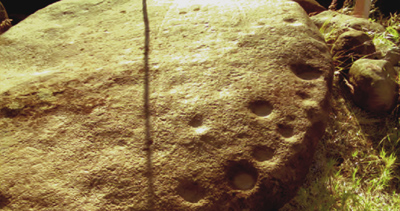
Kānaloa Stone Shadow Alignment
Photo: Kaho'olawe Island Reserve Commission
|
On Kaho'olawe, the smallest island of the Hawaiian island chain only 7 miles from Maui, sits an endangered and sacred rock, the Kānaloa, with petroglyphs and a row of 32 cupules (man-made depressions) along one edge. “It has significant celestial alignments with the rising and setting of the sun,” said Michael Naho'opi'i, Executive Director of the Kaho'olawe Island Reserve Commission (KIRC). It appears that there is a relationship between the shadow of a stick held vertically along lines etched in the stone and the cupules.
Documented as Site 110 feature BU, the Kānaloa stone is relatively flat and rests on a natural pedestal that when tapped, resonates with a bell-like ring. But its petroglyphs and alignment cups may soon topple into a nearby and ever growing ravine. In 2010 the Commission approved "The Cultural Use Plan: Kūkulu Ke Ea A Kānaloa" with one of the recommendations to preserve and stabilize the stone. The first phase of the plan has been to document the stone's celestial alignments and quantify the erosion forces acting on its base.
New Insights into Ancient Sundials
- Details
- Hits: 18662
Larisa N. Vodolazhskaya of the Department of Space Physics at Southern Federal University (SFU), Rostov, has brought two ancient time keepers together with a new and startling result. The story starts at the turn of the end of the 19th century with the discovery of an L-shaped bar found in the tomb of Thutmose III (1479-1425 BCE). that appeared to be a sundial. In the 1930's a "user manual" of sort was found carved on the tomb ceiling of Seti I (1290-1279 BCE) at Abydos. The ideal L-shaped bar had lines engraved with distances from a starting mark of 3, 6, 9, and 12 units. The Seti I text describes these spacings as "an established procedure". But what is the procedure?
al-Biruni's Cosmos
- Details
- Hits: 14385
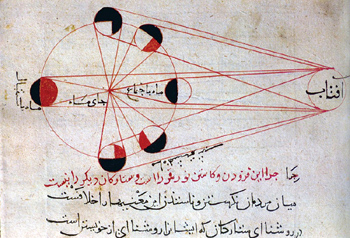
Al-Biruni's diagram of the moon's phases.
Credit: photo reproduction from Seyyed Hossein Nasr, Islamic Social Science: An Illustrated Study (World of Islam Festival Publishing Co., 1976).
Photo use for non-profit educational purposes only.
|
Ibn al-Shatir, whom we give credit for inventing the first modern sundial with gnomon pointing to the celestial pole in 1371 C.E., is but one of many scientific scholars of Central Asia during the “Eastern Renaissance” that lasted from about 800 to 1500 C.E. In this week’s issue of Science, [20 June 2014] Richard Stone reviews the accomplishments of Abu Rayhan al-Biruni (born 973 C.E.) and the possibility that he "discovered" the American continent.
Situated at the crossroads of cultures from China, India, the Middle East, and Europe, al-Biruni was an acomplished astronomer at an early age. At 16 he measured the height of the midday sun and calculated the latitude of his hometown, now in present day Khiva, Uzbekistan.

